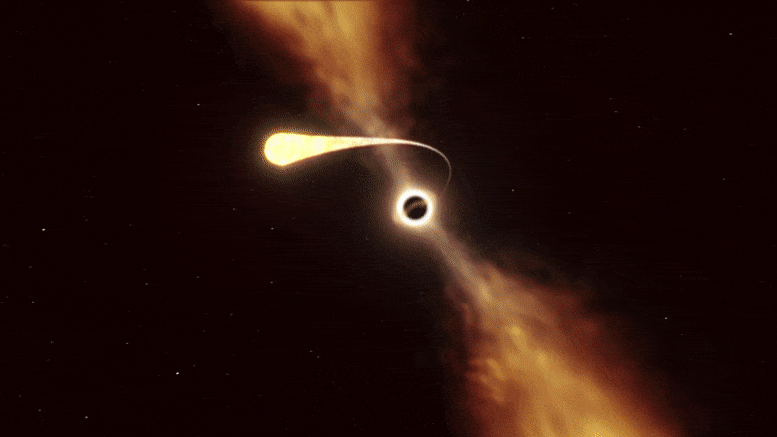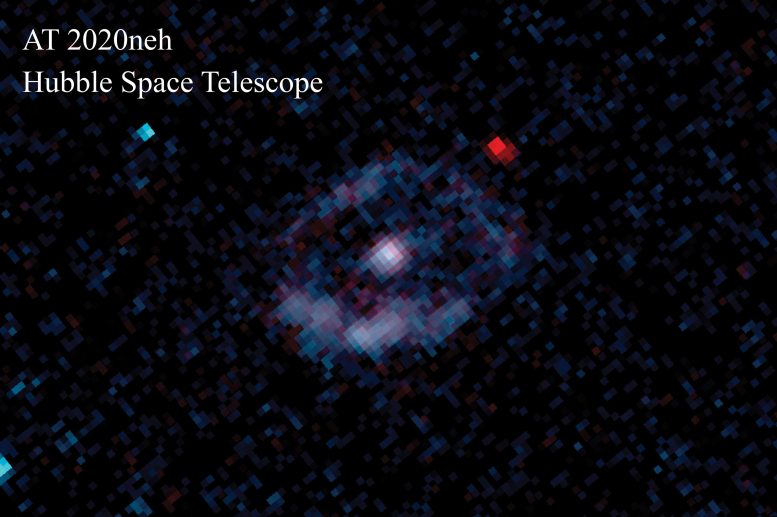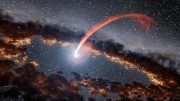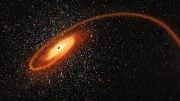
This animation depicts a star experiencing spaghettification as it’s sucked in by a black hole during a ‘tidal disruption event’. Credit: ESO/M. Kornmesser
Scientists hope to improve their understanding of the growth of supermassive black holes in massive galaxies by studying intermediate-mass black holes.
After lurking undetected in a dwarf galaxy, an intermediate-mass black hole revealed itself to astronomers when it gobbled up an unlucky star that strayed too close. Known as a “tidal disruption event” or TDE, the violent shredding of the star produced a flare of radiation that briefly outshone the combined stellar light of the host dwarf galaxy. This observation could help scientists better understand the relationships between black holes and galaxies.
The flare was captured by astronomers with the Young Supernova Experiment (YSE), a survey designed to detect cosmic explosions and transient astrophysical events. An international team led by scientists at UC Santa Cruz, the Niels Bohr Institute at the University of Copenhagen, and Washington State University reported the discovery in a paper published today (November 10) in Nature Astronomy.
“This discovery has created widespread excitement because we can use tidal disruption events not only to find more intermediate-mass black holes in quiet dwarf galaxies, but also to measure their masses,” said coauthor Ryan Foley, an assistant professor of astronomy and astrophysics at UC Santa Cruz who helped plan the YSE survey.
First author Charlotte Angus at the Niels Bohr Institute said the team’s findings provide a baseline for future studies of midsize black holes.

Astronomers discovered a star being ripped apart by a black hole in the galaxy SDSS J152120.07+140410.5, 850 million light years away. Researchers pointed NASA’s Hubble Space Telescope to examine the aftermath, called AT 2020neh, which is shown in the center of the image. Hubble’s ultraviolet camera saw a ring of stars being formed around the nucleus of the galaxy where AT 2020neh is located. Credit: NASA, ESA, Ryan Foley/UC Santa Cruz
“The fact that we were able to capture this midsize black hole whilst it devoured a star offered us a remarkable opportunity to detect what otherwise would have been hidden from us,” Angus said. “What is more, we can use the properties of the flare itself to better understand this elusive group of middle-weight black holes, which could account for the majority of black holes in the centers of galaxies.”
Supermassive black holes are found at the centers of all massive galaxies, including our own Milky Way. Astronomers conjecture that these massive beasts, with millions or billions of times the mass of the sun, could have grown from smaller “intermediate-mass” black holes with thousands to hundreds of thousands of solar masses.
One theory for how such massive black holes were assembled is that the early universe was rampant with small dwarf galaxies with intermediate-mass black holes. Over time, these dwarf galaxies would have merged or been gobbled up by more massive galaxies, their cores combining each time to build up the mass in the center of the growing galaxy. This merger process would eventually create the supermassive black holes seen today.
“If we can understand the population of intermediate-mass black holes out there—how many there are and where they are located—we can help determine if our theories of supermassive black hole formation are correct,” said coauthor Enrico Ramirez-Ruiz, professor of astronomy and astrophysics at UCSC and Niels Bohr Professor at the University of Copenhagen.
But do all dwarf galaxies have midsize black holes?
“That’s difficult to assert, because detecting intermediate-mass black holes is extremely challenging,” Ramirez-Ruiz said.
Classic black hole hunting techniques, which look for actively feeding black holes, are often not sensitive enough to uncover black holes in the centers of dwarf galaxies. As a result, only a minuscule fraction of dwarf galaxies is known to host intermediate-mass black holes. Finding more midsize black holes with tidal disruption events could help to settle the debate about how supermassive black holes form.
“One of the biggest open questions in astronomy is currently how supermassive black holes form,” said coauthor Vivienne Baldassare, professor of physics and astronomy at Washington State University.
Data from the Young Supernova Experiment enabled the team to detect the first signs of light as the black hole began to eat the star. Capturing this initial moment was pivotal to unlocking how big the black hole was, because the duration of these events can be used to measure the mass of the central black hole. This method, which until now had only been shown to work well for supermassive black holes, was first proposed by Ramirez-Ruiz and coauthor Brenna Mockler at UC Santa Cruz.
“This flare was incredibly fast, but because our YSE data gave us so much early information about the event, we were really able to pin down the mass of the black hole using it,” Angus said.
Reference: “A fast-rising tidal disruption event from a candidate intermediate-mass black hole” by C. R. Angus, V. F. Baldassare, B. Mockler, R. J. Foley, E. Ramirez-Ruiz, S. I. Raimundo, K. D. French, K. Auchettl, H. Pfister, C. Gall, J. Hjorth, M. R. Drout, K. D. Alexander, G. Dimitriadis, T. Hung, D. O. Jones, A. Rest, M. R. Siebert, K. Taggart, G. Terreran, S. Tinyanont, C. M. Carroll, L. DeMarchi, N. Earl, A. Gagliano, L. Izzo, V. A. Villar, Y. Zenati, N. Arendse, C. Cold, T. J. L. de Boer, K. C. Chambers, D. A. Coulter, N. Khetan, C. C. Lin, E. A. Magnier, C. Rojas-Bravo, R. J. Wainscoat and R. Wojtak, 10 November, Nature Astronomy.
DOI: 10.1038/s41550-022-01811-y
This study was based on data from observatories around the world, including the W. M. Keck Observatory in Hawaii, the Nordic Optical Telescope, UC’s Lick Observatory, NASA’s Hubble Space Telescope, the international Gemini Observatory, the Palomar Observatory, and the Pan-STARRS Survey at Haleakala Observatory.









How were you able to see all of the “eating” of the Star from the Black Hole? I thought these events took a very long time to happen? At least, much longer than we would be alive, I would think? But, you show that the Black Hole ingests the Star in quite a short time. I mean I know that the video is sped up, and that it is just a facimile, but still, wouldn’t it still be getting ingested?!
It seems to me the term blackhole is a kind of metaphor for bigger star.
It seem to me they cover the giant star seemingly to shield their eyes.
It seems to me like they are misleading layppl with this.
It’s an animation (imagination).
Why they won’t be upfront about it only they know; but I can speculate: it affects their tenure, gives them an aura of professionalism, keeps a cap on social creativity, it fits into their socio-religio-economic-political agenda.
Maybe they don’t want to scare the public even more. The fact that there are other earthlike planets indicates potential alien life on other planets. Stars eat/absorb stars. Animals eat animals too. The cold dark evil reality of existence and survival. But no child needs to know that while they’re being systematically programmed at school; they’ll find out later (after their good years have been sucked out of them).
They monitored the black hole for 400 days. The TDE rip phase was over after a few days. The rest of the light production is perhaps due to the accretion disk material – including the newly added star material that didn’t get swallowed in the rip phase – being slowly siphoned in.
“AT 2020neh reached peak brightness on 1st July
3 2020, and was monitored with multi-wavelength follow-up observations for over 400 days from peak in the rest frame (for details of the follow-up campaign, see Methods)”
“With information on the evolution of AT 2020neh down to 3% of its maximum light, we measure a rise time from initial detection to g-band peak of only 13.2 ± 1.0 days in the rest frame. To date, this is the fastest measured rise time for a TDE, on average a factor of 2.4 +3.0 −1.5 times faster
than others with pre-max light curve coverage.”